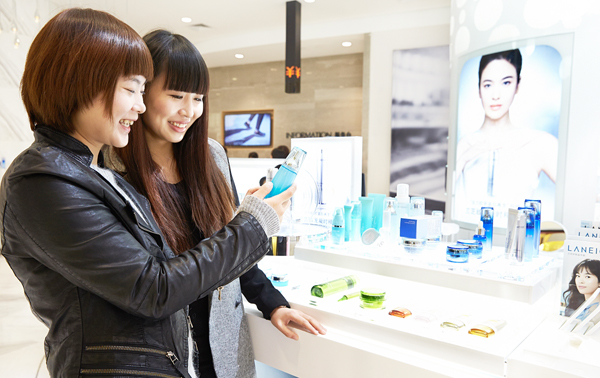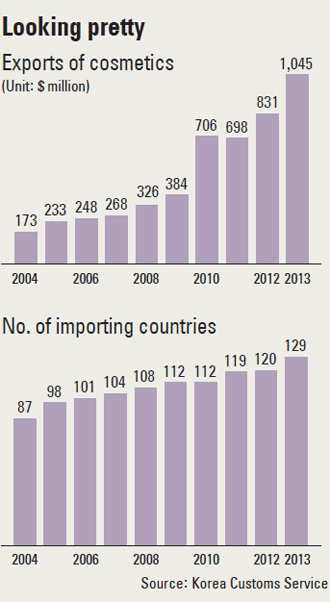Demand for cosmetics abroad is still growing

“They are mad about Korean face packs,” Ahn said. “They say the packs are of good quality and they can feel their skin rejuvenate after using them.”
Ahn’s friends are part of a growing number of overseas consumers taking notice of Korean cosmetics. According to the Korea Customs Service yesterday, the export volume of local cosmetics jumped six times in the past 10 years while the range of importing countries widened impressively.

In the first quarter of this year, exports reached $288 million, up from $233 million the previous year.
The number of importing countries 10 years ago was 87, which reached 129 last year.
“The biggest product in terms of volume was skin care products, while demand for cosmetics was also high,” said an official from the customs agency. “Based on our analysis, exports have increased because of the attention being paid to the fashion and makeup styles of Korean actors, actresses and singers.”
Items that appeared in hit dramas like “My Love from the Star” were particularly popular. In China, the makeup and fashion items used by protagonist Cheon Song-yi, like lipsticks, bags and coats, were sought out by consumers.
As for exports by region, data showed that demand was high in China, Japan and Southeast Asian countries. In 2004, the top five countries importing Korean cosmetics were, in order, China, the United States, Japan, Hong Kong and Taiwan. In 2013, the order changed slightly as Asia became the main market. The top market was China, followed by Hong Kong, Japan and the U.S.
“The cosmetics industry is one that creates jobs as it involves labor-intensive work,” the official said. “Growing cosmetics exports are a good sign for the Korean economy as a whole.”
Growing exports have buoyed Amorepacific Group’s sales.
The conglomerate, which owns major cosmetics brands like Etude House and Innisfree, announced its first quarter performance yesterday, highlighting sales that jumped 16.3 percent on-year to 1.14 trillion won ($1.1 billion) and operating profit that increased 23.1 percent to 213.9 billion won over the same period.
Of the total, sales generated by the conglomerate’s cosmetics affiliates reached 1.08 trillion won, up 18.3 percent from the previous year, while operating profit was 213.9 billion won, a 24.2 percent increase from the previous year.
Amorepacific also has non-cosmetics businesses that sell beauty aids like diet drinks and cosmetics packaging. Operating profits for the non-cosmetics businesses dropped 12.2 percent in the first quarter.
In particular, sales of Amorepacific Co., a cosmetics affiliate that manages brands like Sulwhasoo, Hera and IOPE, reached 931.8 billion won, up 16 percent from the previous year, while operating profit went up 25 percent to reach 175.7 billion won. Of its total sales, 192.3 billion won was from exports overseas, increasing 49.7 percent from the previous year.
“Our products were especially popular in the Asean region, along with China and Japan, based on the so-called K-beauty trend,” said an official from the conglomerate.
BY LEE EUN-JOO [angie@joongang.co.kr]










with the Korea JoongAng Daily
To write comments, please log in to one of the accounts.
Standards Board Policy (0/250자)